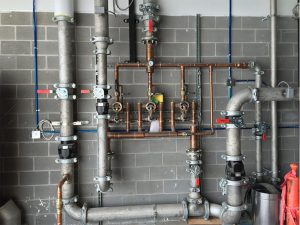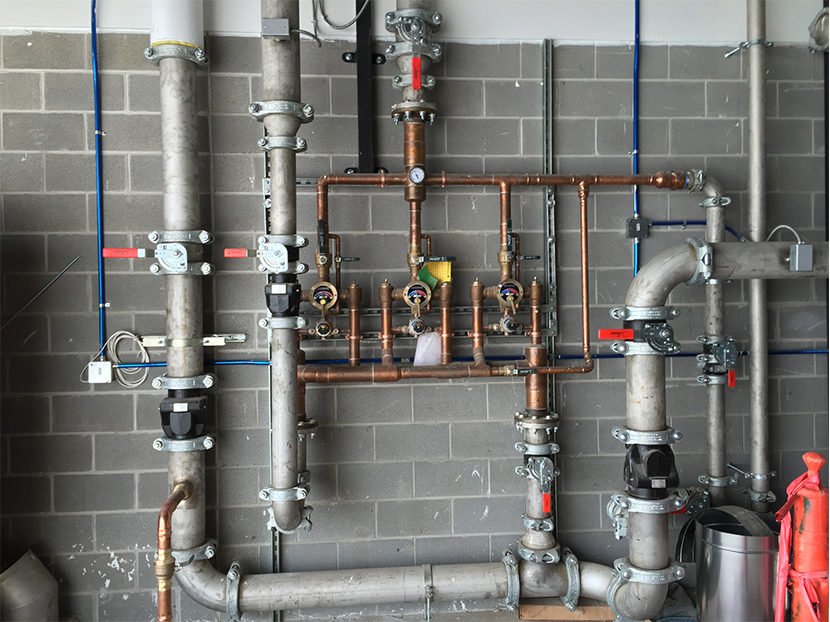Having noisy water may not only create inconvenience in your home, but the noise can also be extremely irritating to your ears. Aside from this what might be more disturbing is that noise indicates underlying an underlying problem with your pipes.
However, these problems can cause damage to other plumbing systems which may lead to huge repair costs in the future. So it is necessary to pay heed to the noise and fix them urgently.
One of the most ways to quiet your noisy water pipe is to tighten up loose fittings, replace worn-out washers, Insulate copper pipes, and install a water hammer arrestor.
In this, we will talk more about this in detail and other methods to help you quiet your noisy pipe.

How to Quiet Noisy Water Pipes
1. Check Out the Air Chamber
The air chambers are installed near the taps to serve as a shock absorber for the fast-moving water when the tap is turned off. The air chambers are normally filled with air to compress and cushion the fast-moving water and prevent it from banging into the valves anytime the taps are turned off. Thus stopping the force of the water otherwise would induce the hammering and rattling noise in your pipes.
However in the long run water will begin to replace the air bit-by-bit hence decreasing the ability of the air to cushion the water .when this happens the fast-moving water slams into the valves; creating that thumping noise.
To get off the noise, you need to refill the air supplies of the chamber.
To replenish the air, these are steps you need to follow.
- Turned off the main water supply to your house.
- Turn on all the taps in the top story of your house.
- Turn on all the taps at the bottom of your house.
- Wait for some time and allow all the water to drain from your system completely.
- After all the water had drained (no water coming from the taps)entirely turned on the water supply.
- Wait a bit and let the water flush out any air within the pipes while the taps remain.
- Do not turn off all the taps.
These methods will restore air within the air chamber and help cushion fast-moving thus eliminating the water hammering noise.
Also Read:
How to quiet a noisy air return
2. Set Up a Water Hammer Arrestor
There are devices out there that you can use to attach to your taps to serve as the air chamber and provide the same function. These are made with spring-loaded shock absorbers that redirect the force of the water anytime the tap is shut. These devices are more effective than air chambers as they can never be waterlogged. You may hire a professional plumber to assist attach the water hammer arrestor to your taps.
3. Tighten Up Loose Fittings
In most cases, water passes through the pipework to your home and it allows the movement of water in your home. The water rapidly passes through the pipework in large volumes, hence the pressure makes the pipes sway and makes a rattling noise. Sometimes the pressure can also cause the pipes to hit the walls and any other objects near them, hence creating banging noise in the process.
This can happen when your pipes are poorly fitted or are not fitted properly. The pipe fittings can also become loose over time
To Fix this problem you need to look out for the fittings and tighten up the bolts and nuts properly, you can also replace worn-out fixtures if there is the need to do so It is also good to add cushioning foams to pipe anchor traps and tighten them up.
4. Insulate Copper Pipes
Most of the pipework in your home is made from copper. This is because copper is long-lasting and malleable which has come to replace both lead and steel in the present day. One thing about copper is it expands and contracts.
It expands when you use hot water due to the heat and this usually results in the pipe rubbing against the joints, support structures, brackets, and other objects closer to it. It is this that creates the noise.
If you only hear the noise after using hot water, then it is caused by the expansion of the copper and there is no need to worry much as the copper pipes are adaptable to stress. But if the noise is becoming a pain in the ass, then here are some approaches to help you get rid of the noise.
Any of the pipework you get your hands on can be insulated with rubber foam and this will reduce friction against other surfaces. You can decrease the temperature of the hot water to cut down the expansion.
In extreme cases, you can get a professional to come and insulate pipes that are beyond your reach and are buried in the drywall.
5. Remove Clog and Sludge Build-Up in Your Pipe
Sometimes the noise from your pipe may be caused by the accumulation of clogs within drain pipes This occurs when water cannot run out of the drain pipe properly hence creating noise. The drain pipe clogs can include grease, hair soap scum, and other objects that may fall into the drain these things later build up and reduce the flow of water.
Pipework of homes in hard water areas can wear out in the long run. Also, the central heating systems may create a sledge that will circulate in the pipes. In both instances, the particles will circulate in the pipes and create a rattling or clicking noise.
When there is a build-up of the sledge in your pipes then you need not do any but call a professional to come to fix it.
But you can unclutter clog from the drain pipes using a plunger to help push the clog through the pipe. You can also use a plumbing snake to help break hard clogs within the pipe. You can also call up a professional if you can’t use the plunger or a plumbing snake.
6. Check Out the Pressure Regulator
The water pressure might be the cause of the noise you hear from your pipes. Water rapidly forced through pipework with high pressures can induce a banging noise as a result of water smashing around. To solve this problem you need to test the pressure regulator of your pipe. Buy a pressure testing gauge at the local hardware shop, if you don’t have one.
Attach the pressure testing gauge to the outside faucet that is regulated. In my ass, the faucet normally comes out from the wall. Now turn on the water faucet and record the readings, which are usually in pounds per square inch. If the readings exceed 80 psi you need to call a plumber to come and replace the pressure regulator.
7. Replace Worn-Out Washers
Another reason for the noise in your pipes may be due to worn-out washers or valves in the tap. You may hear a squealing noise from the valves that connect to the tap or the washing machine when it is worn out.
To Fix this issue, you need to shut off and check out the washers inside the hose. Replace them if you find out they are worn out or cracked on the surface.
If this approach doesn’t work then shut off your house’s main water supply and repair the faucet. It might be that one of the tape washers is worn out or the valve seat is worn out. which is causing the pipe to be noisy.
8. Replace Worn-Out Ballcock Assembly
If you hear a banging or rattling noise after flushing then the ballcock might be the cause of the problem. The ballcock is responsible for controlling the filling process of your toilet. Based on how your ballcock assembly is designed you may be able to repair or replace it.
Final Thought
Having a noisy pipe in your home is never fun it can be very annoying to hear those weird noises anytime turn on your tap. Luckily enough we have compiled some of the best approaches to help you solve this problem. Read the article clearly and choose the easiest method to help fix your noisy pipe. You can also call up a professional plumber for a quick fix to the issue.
- How to Chew Quietly While Eating-Effective Tips - April 14, 2023
- Why is My Clutch Pedal Squeaking – Causes & Fixes - April 14, 2023
- Propane Tank Making Hissing Noise (Solved) - February 25, 2023

